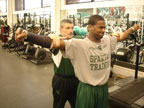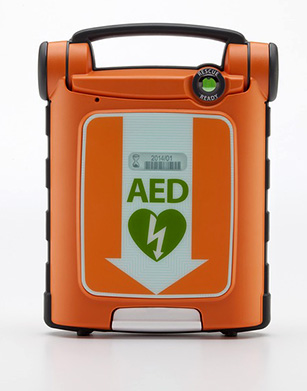Powerline: Training the injured athlete
As much as we would like to believe that injuries could be prevented, the fact remains that they are an unavoidable part of all sports.
In addition to the physical pain and the impending rehabilitation process, the athlete must deal with the frustration of lost playing time. This emotional distress can not only affect the athlete, but also transcend to family members, the team and the coaches.
 Ask any athletic trainer, sports physician or sports psychologist about what should be done with injured athletes, and the resounding answer will be, “Keep them as physically active as their injury allows.”
Ask any athletic trainer, sports physician or sports psychologist about what should be done with injured athletes, and the resounding answer will be, “Keep them as physically active as their injury allows.”
Athletes are what they are, in large part, because of their magnetic draw to physical activity. When an injury is sustained that is severe enough to sideline them for a significant period, it can wreak havoc on their sense of purpose and self-esteem. When activity is introduced to the rehabilitation process, that welcomed sparkle tends to return to their eyes.
Obviously, the paramount prerequisite in designing an action plan for the injured athlete is to bring all of the involved parties — the athlete, primary care physician, athletic trainer, and strength/conditioning coach — together for deliberations and a consensus on that plan.
Let’s troubleshoot some of the major concerns and issues that surface when dealing with injured athletes, and then follow those with some personal perspectives and suggestions that can help you when these unenviable, yet inevitable, situations occur.
Deliberation and decision making
The nature and severity of the injury are integral components in constructing the rehabilitation plan.
A short list of concerns, in no particular order, include:
- Is the injury surgical or non-surgical?
- Is the injury basically soft tissue (i.e., muscle, connective tissue, etc.), or is there bone involvement?
- Did the injury required stitches, and was it an “open” injury?
- What is the extent of the vascular damage and how much swelling has been shunted to the area?
 Each of these situations, along with their extenuating circumstances, dictate the initiation, frequency, type, and progression model for the rehabilitation undertaking. All of the involved parties who eventually lend their expertise to the process must have a clear definition of the chosen path.
Each of these situations, along with their extenuating circumstances, dictate the initiation, frequency, type, and progression model for the rehabilitation undertaking. All of the involved parties who eventually lend their expertise to the process must have a clear definition of the chosen path.
The inception of the rehab layout is always under the direct supervision of the attending physician and athletic trainer or assigned physical therapist. Together with the strength/conditioning coach, documentation of the injured athlete’s pre-injury movement/strength levels are matched with an evaluation of the post-injury movement/strength levels in order to assess the current status of these important variables. A new starting point must be determined in order to track progress.
Strength/conditioning coaches are called upon for their input and skills during the later part of the first stage of rehab on the injured area, and during the entire blueprint for the rest of the athlete’s body.
» ALSO SEE: 5 nutrition tips for training and recovery
In other words, the S/C coach devises a training system — with approval from the primary care physician and sports medicine staff — for all of the muscle groups that are in no way affected by the injury. This includes areas proximal (above) and distal (below) to the injury site whenever possible. Even if activity for the affected limb is initially contraindicated, consent may be given to train the uninjured limb. Other than the fact that you want to keep all healthy areas progressively strong, doing this actually provides some benefits to the contralateral injured limb.
Referred to extensively in both peer-reviewed literature and the popular press, there is a neuromuscular process known as “cross-transfer” (or “indirect-transfer”), which essentially means that some strength gains, albeit minimal, can be experienced in the injured limb via this process.
Examples: In the case of an elbow injury, resistance to the shoulder area would continue for the anterior, medial, posterior, and rotator cuff musculature with physician clearance. The same holds true in the case of a knee injury, where work would be performed for the upper thigh, hip flexion, hip extension, inner and outer thigh/hip regions, as well as the calf and ankle. Again, all of this would be assigned with the approval and under the auspices of the medical and sports medicine staffs.

Those involved in the second phase of rehab must understand that there may be an extended period of time when the injured athlete will be required to keep the affected area “quiet,” indicating absolutely no unnecessary movement. This is almost always the case in bone fractures and injuries requiring surgical intervention. These are two of the more serious types of injuries that stress the body’s recovery systems to a much higher level, thus necessitating a longer period of inactivity.
Once training procedures can be instituted, they may include such rudimentary activities as body weight exercises, manual resistance/massage applications, and hydra-training in a small lap or therapy pool replete with a resistance mechanism.
Eventually, the athlete can evolve to upper/lower body ergometers — both weight bearing and non-weight bearing modes — for programmed work bouts that can produce feedback (e.g., heart rate and power output) for documenting progress. Frequency and duration can be manipulated according to the athlete’s recovery schedule and in response to the overall healing process.
By the time the athlete can advance to more involved, detailed, and intense activities in the weight room, he/she should have a much more positive mental disposition on the progress being made, and for the brighter prospect of returning to the game.
Tracking progress
Athletes are mentally and physically driven by results. Progression is certainly a key ingredient in all training endeavors, but it is an especially vital constituent in rehab design.
Remember: The athlete now has a new “starting point,” which is significantly inferior to what had been the status quo for so long. This can be a severe blow to the psyche, and one of the ways to remedy those sad, puppy-dog eyes peering at you for some answers is to be able to produce some positive, concrete progress results – even if they are coming at a snail’s pace.
Additionally, tracking and comparing the initial post-injury strength level with subsequent gains provides invaluable information on the healing process and enables you to make informed decisions on increasing duration, frequency, and intensity of the workloads.
Back in the lineup
With due diligence, a lot of steady, progressive work and evaluation, the time will come when the athlete can be re-introduced to some light sport and/or position specific work. The training protocol now takes on a heavy “functional” emphasis, and the athlete should be in high gear both mentally and physically with the reality of returning to play looming on the horizon.
While many functional aspects may have been gradually interwoven into the rehab process up to this point, the sports medicine and strength staffs are closer to making a determination on a target date to become more aggressive in training specificity and getting back to nearly full speed in performing the skills required of the sport in question.
Our advice is to keep strict controls on the frequency, duration, and intensity of the newly incorporated skill phase in order to allow the neural and muscular systems ample time to adapt to the stresses that have been on hiatus for a while.
Final rep
Nothing is more aggravating, frustrating, and depressing for young athletes who truly love their game than an injury resulting in a significant loss of playing time.
The benefits of an active rehab process that is planned, supervised, charted, and completed with a high level of expertise and great care supersedes the physical – it also gives the athlete a renewed mental outlook to return to the game even stronger than before.
TIP FROM THE TRENCHES: Returning to the weight room
Once permission is granted from the medical and sports medicine staffs to revive strength-training procedures for the injured area, the strength-training practitioner must develop a plan that gradually, progressively stimulates strength gains without overdoing it and creating a setback. Here are a few suggestions to assist you with implementing this phase of the rehab system:
- Start with some lightly applied manual resistance to the working musculature to determine if there are any points along the positive (raising) or negative (lowering) movement paths where the athlete is unable to sustain an appreciable contraction due to some type of neuromuscular deficit. If you detect such a deficit or “break” in the contraction, discuss it with the sports medicine staff.
- Unilateral machine work provides another ideal starting point with many injury situations, as the athlete will have an easier time balancing the load. Additionally, there is a built-in safety mechanism in that if the load is inadvertently dropped, it can usually be done without incident. Once control and strength is developed satisfactorily with the machines, the athlete can move on to some free weight modes.
- The athlete probably isn’t able to handle an inordinate amount of weight, so increase the repetition target (anywhere from 12-20 reps) and place a strict cadence on the reps (e.g., 3 seconds for the positive phase, 5 seconds for the negative phase). This will increase the duration of the set, and provide more work per set to help compensate for the reduced weight load. In other words, you are substituting quantity for quality in this early weight room phase. Total sets/reps should be discussed and determined in conjunction with the sports medicine staff until the athlete is deemed healthy enough to return in earnest to the base strength training program.
Ken Mannie is the head strength and conditioning coach Michigan State University. His column, Powerline, appears regularly in Coach & Athletic Director magazine.





